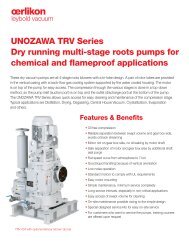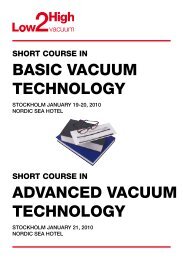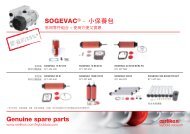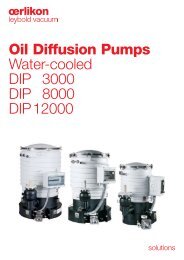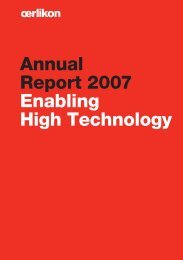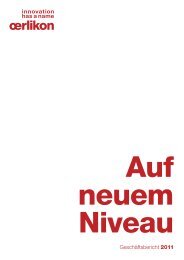Annual Report 2011 (5.07 MB, PDF-File) - Oerlikon
Annual Report 2011 (5.07 MB, PDF-File) - Oerlikon
Annual Report 2011 (5.07 MB, PDF-File) - Oerlikon
Create successful ePaper yourself
Turn your PDF publications into a flip-book with our unique Google optimized e-Paper software.
Remuneration <strong>Report</strong> Risk Management Financial <strong>Report</strong> Global Markets R & D Global Presence<br />
Food<br />
Agriculture needs more efficient means<br />
of production<br />
According to projections, by 2050, around 9 billion people will<br />
inhabit the Earth – over 30 % more than today. But according<br />
to the United Nations Food and Agri culture Organization (FAO)<br />
study “How to Feed the World in 2050”, the global demand for<br />
food will rise at a faster rate than population growth. By 2050,<br />
demand for food will have increased by 70 %.<br />
A key driver of this is the emergence of a rapidly expanding<br />
middle class in the world’s cities, particularly in Asia. Whereas<br />
just 40 % of the Asian population lived in urban areas a decade<br />
ago, this figure is forecast to reach 55 % by 2030. City residents<br />
tend to have greater purchasing power and consume<br />
significantly more processed food than those who live in rural<br />
areas. As urbanization increases, so, too, does the demand for<br />
relatively expensive foods such as meat and dairy products.<br />
In China, for instance, meat consumption has been growing at<br />
roughly the same pace as the economy, doubling from 25 kilograms<br />
per person in 1980 to 50 kilograms in 2005. Global demand<br />
for meat is likely to continue rising: in 2000, 20 % of the<br />
calories consumed in developing countries were from meat,<br />
dairy products and plant oils. According to the FAO, this figure<br />
is expected to increase to 29 % by 2050. 470 million tons of<br />
meat – twice as much as today – will be required to meet this<br />
demand, and production of plant-based animal feed will have<br />
to increase proportionally. For example, the amount of soy-<br />
Food<br />
Segment split<br />
Textile Drive Systems Vacuum Solar Coating Advanced<br />
Technologies<br />
End usage of <strong>Oerlikon</strong> innovations<br />
Tractors Trucks Equipment PET Packaging Freezing<br />
153<br />
beans grown would have to double in comparison with today’s<br />
figures to reach 515 million tons by 2050.<br />
To grow, harvest and process such large quantities of food,<br />
agricultural and food industry productivity must significantly improve.<br />
The productivity gap between developed and emerging<br />
countries is still very large: average crop yields in the world’s<br />
richest nations are about 300 % higher than in poorer<br />
countries.<br />
How <strong>Oerlikon</strong> participates<br />
Efficient farming – by, for instance, sowing high-yield varieties<br />
of plants or applying effective fertilizing agents – can only be<br />
achieved with high-performance agricultural machinery. This<br />
trend is energizing business at <strong>Oerlikon</strong> Drive Systems, a leading<br />
supplier of high-performance power-train solutions for tractors,<br />
combines and other agricultural machinery.<br />
The increased consumption of processed foods is benefiting<br />
<strong>Oerlikon</strong> Vacuum, too. The segment produces robust, highperformance<br />
vacuum systems used in the food industry packaging<br />
process; removal of ambient air from around food products<br />
maintains quality and lengthens shelf life.<br />
The packaging industry also employs coated molds for such<br />
applications as PET bottle manufacturing. These and other<br />
press molds are coated using <strong>Oerlikon</strong> Coating facilities and<br />
processes.




